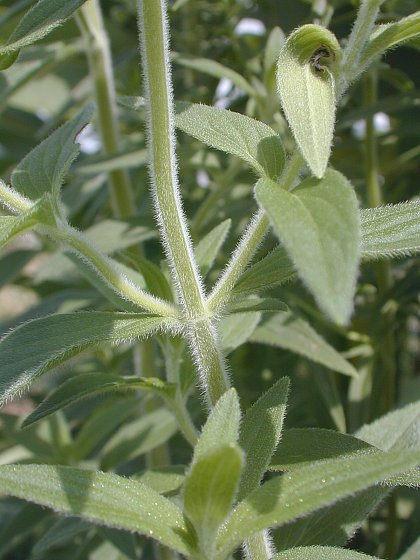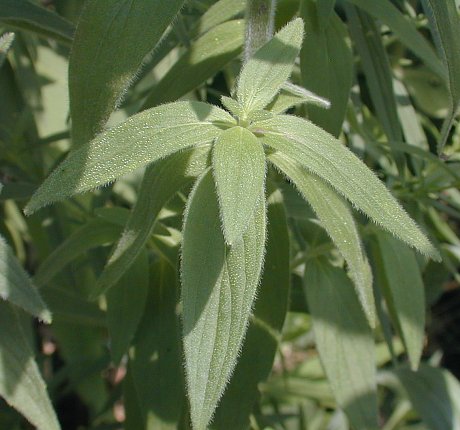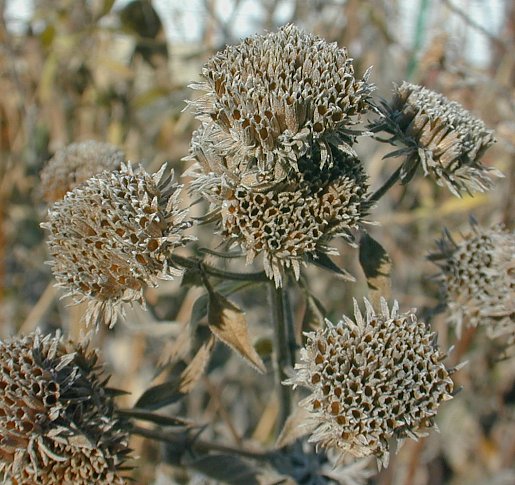Description: This herbaceous perennial plant is 2-4' tall, branching frequently to create a slender bushy appearance. The stems are light green, 4-angled, and densely pubescent on all sides. Pairs of opposite leaves occur along these stems, becoming gradually smaller and more slender as they ascend. These leaves are up to 1-3" long and ¼–¾" across; they are narrowly lanceolate to lanceolate in shape and either sessile or short-petiolate. The leaf margins are entire (toothless) and ciliate. When petioles are present, they are light green and densely short-pubescent. The upper leaf surface is grayish green and short-pubescent, while the lower leaf surface is slightly more pale and densely pubescent. The foliage has a typical mint fragrance. The upper stems terminate in branching flowerheads of flowers; individual heads are flat-topped and densely flowered, spanning up to 1" across.

Each flower is about ¼" long (from upper lip to lower lip), consisting of a 2-lipped corolla, a long-tubular calyx with 5 teeth, 4 stamens, and a pistil. The corolla is white; there are purple specks and dots scattered across its throat and the lobes of its lips. The upper lip of the corolla consists of a short hood, while its lower lip is longer and 3-lobed. The sides of the calyx tube are light green, vertically ribbed, and pubescent; the teeth along the upper rim of the calyx are erect and narrowly triangular in shape. At the base of each flowerhead, there occurs several leafy bracts that are up to 1" long; they are grayish green, lanceolate in shape, and pubescent. The margins of these bracts are entire and ciliate. The blooming period occurs from mid- to late summer, lasting about 1 month. Afterwards, the flowers are replaced by tiny seeds (4 seeds per flower); these seeds are hidden from view by the persistent calyces. Individual seeds are about 1 mm. long, oblongoid in shape, and dark brown. The root system is rhizomatous, often forming a dense tuft of clonal offsets.

Cultivation:
The preference is full or partial sun and moist to slightly dry
conditions. Growth is best in fertile loamy soil, although other kinds
of soil are acceptable, including those that are stony or clayish.
During hot dry weather, some of the leaves may turn yellow and fall
off, but the plant usually survives. Occasionally, some of the leaves
may be affected by rust, especially when a plant is stressed out by
adverse weather or is suffering from transplant shock. This
problem is almost always temporary. Some protection from afternoon sun
and occasional watering during dry spells can keep this plant healthy;
fertilizer is neither necessary nor desirable. Overall, this is an easy
plant to cultivate in gardens.
Range & Habitat:
The native Hairy Mountain Mint occurs occasionally in central Illinois,
but it is uncommon or absent in the southern and northern sections of
the state (see Distribution
Map).
Habitats include black soil prairies, meadows in wooded areas, rocky
upland forests, woodland edges, savannas, thickets, limestone glades,
and
abandoned fields. Hairy Mountain Mint is usually found in higher
quality natural areas, although it may colonize adjacent disturbed
areas. Occasional wildfires or mowing may be beneficial in maintaining
populations of this plant if it reduces competition from woody
vegetation.

Faunal Associations: The nectar-rich flowers are very attractive to many kinds of insects, including honeybees, cuckoo bees (Triepeolus spp., Coelioxys spp.), leaf-cutting bees (Megachile spp.), Halictid bees (Agapostemon spp., Halictus spp., Lasioglossum spp.), Halictid cuckoo bees (Sphecodes spp.), thread-waisted wasps (Ammophila spp.), the Great Golden Digger Wasp (Sphex ichneumoneus), the Black Grasshopper Wasp (Prionyx atratus), bee wolves (Philanthus spp.), paper wasps (Polistes spp.), Eumenine wasps (Euodynerus spp., Stenodynerus spp.), Syrphid flies, bee flies (Exoprosopa spp.), thick-headed flies (Conopidae), Tachinid flies, small- to medium-sized butterflies, and skippers (Robertson, 1929). Because of the frequent bee and wasp visitors to the flowers, parasitoid wedge-shaped beetles (Macrosiagon spp.) are often common on the flowers. These beetles lay their eggs on the flowers, and the hatched larvae attach themselves to their hosts and hitch-hike a ride back to the brood chamber, where they feed on the larvae and their food stores. Mountain mint (Pycnanthemum) is one of the host plants of a a stink bug, Neottiglossa cavifrons (Hart, 1919; Rider, 2009). Among vertebrate animals, Hairy Mountain Mint and other mountain mints have little value as sources of food. The seeds are too small to be of much interest to birds, while mammalian herbivores display little interest in the foliage, probably because of the chemicals that are associated with its strong mint fragrance.

Photographic
Location:
The photographs were taken at the webmaster's wildflower garden in
Urbana, Illinois.
Comments:
Some authorities refer to this plant as Pycnanthemum
verticillatum var. pilosum. The appearance of Hairy Mountain
Mint (Pycnanthemum
pilosum) is similar to other mountain mints (Pycnanthemum spp.),
but its leaves and stems are more hairy. Compared to two prairie
species, Common Mountain Mint (Pycnanthemum
virginianum) and Slender Mountain Mint (Pycnanthemum tenuiflorum),
Hairy Mountain Mint has wider leaves. Other mountain mints that occur
in Illinois are restricted to the southern section of the state, where
they are found primarily in hilly woodlands. The fresh leaves of
Hairy Mountain Mint can be boiled in water to make an excellent
mint-flavored tea (personal observation).